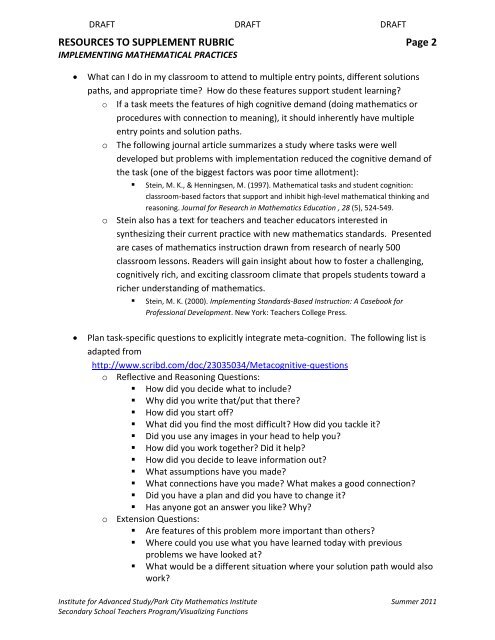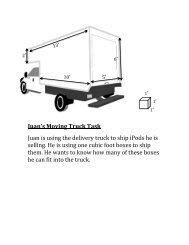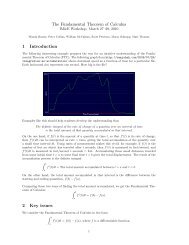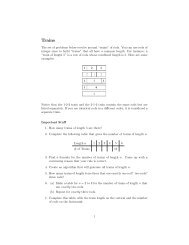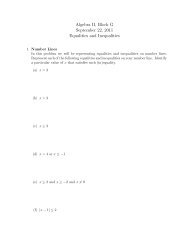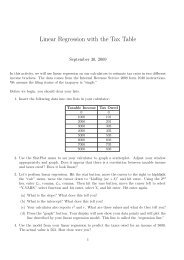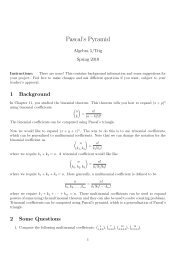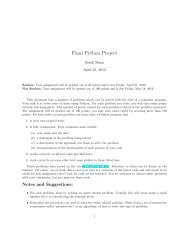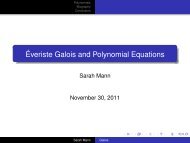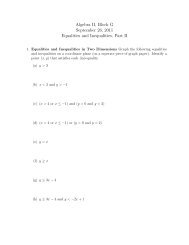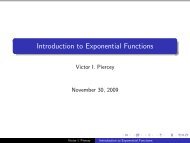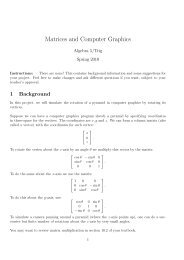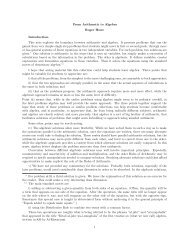Resources to supplement this rubric - Institute for Mathematics ...
Resources to supplement this rubric - Institute for Mathematics ...
Resources to supplement this rubric - Institute for Mathematics ...
You also want an ePaper? Increase the reach of your titles
YUMPU automatically turns print PDFs into web optimized ePapers that Google loves.
DRAFT DRAFT DRAFT<br />
RESOURCES TO SUPPLEMENT RUBRIC Page 2<br />
IMPLEMENTING MATHEMATICAL PRACTICES<br />
What can I do in my classroom <strong>to</strong> attend <strong>to</strong> multiple entry points, different solutions<br />
paths, and appropriate time? How do these features support student learning?<br />
o If a task meets the features of high cognitive demand (doing mathematics or<br />
procedures with connection <strong>to</strong> meaning), it should inherently have multiple<br />
entry points and solution paths.<br />
o The following journal article summarizes a study where tasks were well<br />
developed but problems with implementation reduced the cognitive demand of<br />
the task (one of the biggest fac<strong>to</strong>rs was poor time allotment):<br />
Stein, M. K., & Henningsen, M. (1997). Mathematical tasks and student cognition:<br />
classroom-based fac<strong>to</strong>rs that support and inhibit high-level mathematical thinking and<br />
reasoning. Journal <strong>for</strong> Research in <strong>Mathematics</strong> Education , 28 (5), 524-549.<br />
o Stein also has a text <strong>for</strong> teachers and teacher educa<strong>to</strong>rs interested in<br />
synthesizing their current practice with new mathematics standards. Presented<br />
are cases of mathematics instruction drawn from research of nearly 500<br />
classroom lessons. Readers will gain insight about how <strong>to</strong> foster a challenging,<br />
cognitively rich, and exciting classroom climate that propels students <strong>to</strong>ward a<br />
richer understanding of mathematics.<br />
Stein, M. K. (2000). Implementing Standards-Based Instruction: A Casebook <strong>for</strong><br />
Professional Development. New York: Teachers College Press.<br />
Plan task-specific questions <strong>to</strong> explicitly integrate meta-cognition. The following list is<br />
adapted from<br />
http://www.scribd.com/doc/23035034/Metacognitive-questions<br />
o Reflective and Reasoning Questions:<br />
How did you decide what <strong>to</strong> include?<br />
Why did you write that/put that there?<br />
How did you start off?<br />
What did you find the most difficult? How did you tackle it?<br />
Did you use any images in your head <strong>to</strong> help you?<br />
How did you work <strong>to</strong>gether? Did it help?<br />
How did you decide <strong>to</strong> leave in<strong>for</strong>mation out?<br />
What assumptions have you made?<br />
What connections have you made? What makes a good connection?<br />
Did you have a plan and did you have <strong>to</strong> change it?<br />
Has anyone got an answer you like? Why?<br />
o Extension Questions:<br />
Are features of <strong>this</strong> problem more important than others?<br />
Where could you use what you have learned <strong>to</strong>day with previous<br />
problems we have looked at?<br />
What would be a different situation where your solution path would also<br />
work?<br />
<strong>Institute</strong> <strong>for</strong> Advanced Study/Park City <strong>Mathematics</strong> <strong>Institute</strong> Summer 2011<br />
Secondary School Teachers Program/Visualizing Functions


